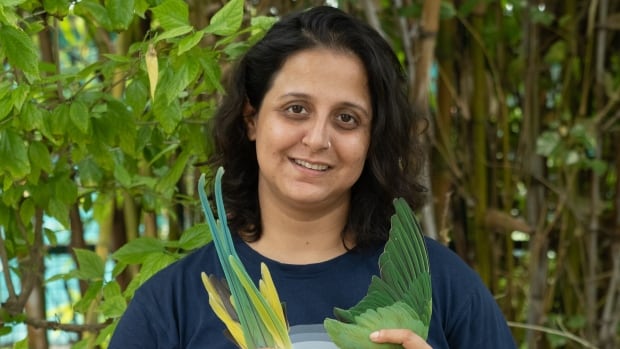[ad_1]
As It Happens6:30Why this woman left a career in architecture to catalogue bird feathers
Esha Munshi has been an architect for 15 years — but her true passion is birds.
“I breathe birds, I paint birds, I read about birds, I look at birds, I record bird sounds. So 24/7, birds are on my mind,” the Ahmedabad, India, woman told As It Happens host Nil Köksal.
During the pandemic lockdowns, Munshi took a two-year online course on bird biology from Cornell University. And now, instead of designing buildings, she puts her aesthetic skills to use by collecting, photographing, measuring and cataloguing the wings and feathers of India’s more than 1,300 bird species.
“I wanted to give something back to science — something related to birds. So I left my architecture career behind and I got into this full time,” she said.
Munshi teamed up with avian veterinarian Sherwin Everett to create the Feather Library, an online database of Indian bird feathers. It’s the first collection of its kind in India, and one of only a handful around the world.
The idea came to her during lockdown when people were mostly inside, and birds were out in full force, she said.
One day she spotted an Indian silverbill outside her home, a species of passerine birds that only grows to about 11 centimetres in length.
While Munshi loves birds, she also has cats, so she has bird netting installed to protect them from her pet predators. But the tiny silverbill managed to slip thorough.
“My cat rushed to attack it, and I happened to rescue [the bird] right in time and release it back. But, in fright, birds tend to lose some of their feathers, and that’s what this little bird did,” she said.

She picked up the handful of feathers in her hand and was fascinated by them. The longest was smaller than her little finger. It made her think about Indian peacocks, whose colourful tail feathers can grown as long as 1.5 metres.
“It just got me curious to know more about feathers,” she said. “Those two are the contradictory feathers, which I have seen, and I wanted to know the entire spectrum in between. And I [wondered] where do I go and find it? And I could not find the answer to it. So I thought: Why don’t I create one?”
FeatherLibrary.com is available for casual birdwatchers and scientists alike, she said.
“Wherever a person would go, if it’s a kid or older person, if one finds a feather lying on the ground, they’ll pick it up. And you know, there’s something about feathers which fascinates everyone,” Munshi said. “So I think the first idea is to create curiosity. The second idea is to create a dataset for the future scientists to look at and to analyze.”

The feathers mostly come by way of Everett, who works at a bird hospital in Ahmedabad.
According to the Feather Library website, his clinic treats between 1,500 and 2,000 birds a year — some commonplace, and some quite rare.
But not every bird makes it, and when they succumb to their injuries and die, their bodies are simply discarded.
Now, rather than let all that potential data go to waste, the avian clinic allows Everett and Munshi to photograph and digitize the feathers and the wings before they are disposed of.
So far, they have catalogued 100 species, of an estimated 1,331 in the country.
“Still a lot of way to go,” Munshi said.

Scott V. Edwards, a Harvard ornithologist who is not involved in the project, called it “super exciting.”
“I think it really will draw attention to the beauty of bird feathers when you can really look at them in detail. And, you know, it also serves some practical uses. People are often trying to identify species by individual feathers, and so this will be a big aid to that,” he said.
“This is really exciting and it’s new. I haven’t really seen anything like it.”
Edwards says it could prove useful for scientists who need to identify bird species as part of their research.
What’s more, he says you can learn a lot about birds based on their wings and feathers — how they attract mates, how they fly, what kind of habitat they occupy, and their moulting patterns throughout the year, for example.
Not to mention, they’re beautiful to behold.
“I think it’s always marvellous how natural selection has just sculpted these exquisite details. It’s not all about survival, though. I think things like bird wings really let us see the exuberance of life and biology,” he said.
“Birds are declining all over the world, and so, hopefully, resources like this will inspire people to remember where they came from and contribute to their longevity in terms of keeping the planet biodiverse.”
[ad_2]
Source link




